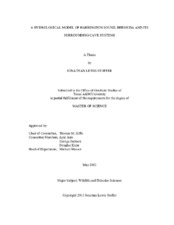| dc.description.abstract | Harrington Sound, located in east central Bermuda, is almost entirely enclosed by land except for a 26.4 m wide channel called Flatts Inlet. This limited connection to the open ocean restricts Harrington Sound’s tides, resulting in a near 3 hour delay and dampening the tidal range to 35% of those on the coast. By comparing the tidal amplitude and surface area of Harrington Sound, tidal exchange can be determined. Past research has shown Flatts Inlet only supplies the Sound with about half of its tidal water. The remaining tidal exchange enters and leaves the Sound either via groundwater influx through pores in the rock or through the traversable passageways of limestone cave systems in the land that encloses the Sound.
The aim of this study was to model hydrodynamic tidal flux and current through marine caves into Harrington Sound. One of the goals of Bermuda’s cave habitat protection plan is to track tidal circulation of water through these cave systems. Information on such cave water transport would facilitate future pollution and nutrient exchange studies. This research was initiated during a six week trip to Bermuda by Jonathan Stoffer as he obtained tidal and water quality data from caves along the perimeter of Harrington Sound. Additional flow data was collected with instruments placed by local cave divers. A YSI 600XLM water quality sonde, Norteck Vector Current Meter, and an in-situ level Aqua TROLL were used to monitor tidal amplitude, periodicity, current velocity, and water quality in cave pools and submerged passages. Profiles of the top 1-2 meters of water at each pool were taken at 56 sites. Tidal gauges were placed in 27 major cave pools surrounding Harrington Sound, as well as Harrington Sound itself, for 48 hours, to monitor tidal propagation through the island. The vector current meter was placed for six weeks to measure water flow in and out of Harrington Sound in six cave passageways known to have high flow rates.
The resulting data have been compared to atmospheric data obtained from the Bermuda Weather Service and analyzed using Microsoft Excel, MATLAB and ArcGIS. The final goal of this project was to create a hydrological model able to predict flow rate and water depth in Bermudian caves with water depth data from the ocean and Harrington Sound.
In constructing a water budget for Harrington Sound, I was able to account for 72.3% of all tidal inflow and 43.3% of all tidal outflow from the Sound as passing through either Flatt’s Inlet or one of the six tested caves. In creating my tidal models, I was able to achieve an averaged sum of squared deviation (SSD) normalized against count ranging from 5.1x10^-4 to 8.4x10^-4 m^2. The flow model achieved a SSD of 3.8x10^-3 m^2. My data also suggest that exchange between Harrington Sound and other inland waters, through cave systems, does exist. | en |


